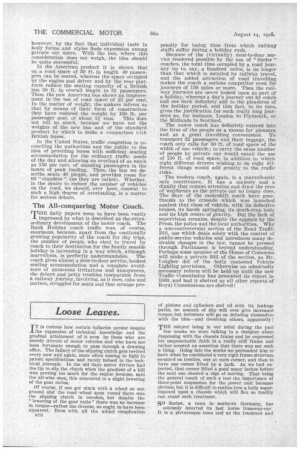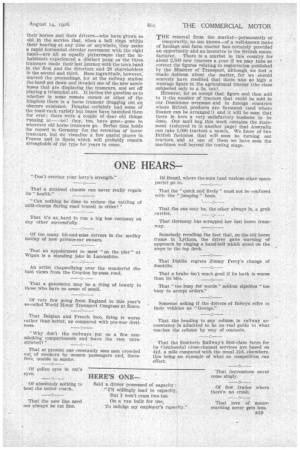Loose Leaves.
Page 44

Page 45

If you've noticed an error in this article please click here to report it so we can fix it.
IT is curious how certain fallacies persist despite the expansion of technical knowledge and the gradual attainment of it even by those who are merely drivers of motor vehicles and who have not been fortunate enough to pass through a drawing office. The fallacy of the slipping clutch gets revived every now and again, more often coming to light in patent specifications and rarely indeed in the technical journals. In the old days motor drivers had the tip to slip the clutch when the gradient of a hill was proving too much for the engine because, said the all-wise ones, this amounted to a slight lowering of the gear ratios.
Of course, if one got stuck with a wheel on wet ground and the road wheel spun round there was the slipping clutch in excels's, but despite the " lowering of the gear ratio" there was no increase in torque—rather the reverse, as ought to have been apparent. Even with all the added complication n18 of pistons and cylinders and oil with its leakage paths, no amount of slip will ever give increased torque, but inventors will go on deluding themselves • with the idea—and' deceiving others, apparently !
THE subject being in our mind during the past few weeks we were talking to a designer about dispensing with the chassis frame and he expressed his unquenchable faith in a really stiff frame and rather scouted an assertion that there was not such a thing. Going into the works we persuaded him to have what he considered a very rigid frame structure mounted on trestles, one at each corner, and then to have one corner lifted by a jack. As we had expected, that corner lifted a good many inches before the next one showed a sign of moving. That being the general result of such a test the importance of three-point suspension for the power unit becomes obvious, but it is difficult to realize how a body superimposed upon a chassis which will flex so readily can stand such treatment.
SO Zerhst, a town in northern Germany, has solemnly interred its last horse tramway-car. It is a picturesque town and as the tramcars and their horses and their drivers—who have grown so old in the service that, when a bell rings within their hearing at any time or anywhere, they make a rapid horizontal circular movement with the right hand—are all so equally picturesque that the inhabitants experienced a distinct pang as the three tramcars made their last journey with the town band in the first and the directors and 28 shareholders in the second and third. Base ingratitude, however, marred the proceedings, for at the railway station the band got down and invaded one of the new motor buses that are displacing the tramcars, and set off playing a triumphal air. It incites the question as to whether in some remote corner or other of the kingdom there is a horse tramcar dragging out an obscure existence. Douglas certainly had some of the toast-rack variety but buses have banished them for ever ; there were a couple of dear old things running at—no t they, too, have gone—gone to wherever old horse tramcars go. Zerbst thus holds the record in Germany for the retention of horse tramcars, but we visualize , a few quaint places in France and in Spain which will probably remain strongholds of the type for years to come. THE removal from the market—permanently or temporarily, no one knows—of a well-known make of haulage and farm tractor has certainly provided an opportunity and an incentive to the British manufacturer. There is a market in this country for about 2,500 new tractors a year if we may take as correct the figures relating to registration published by the Minister of Transport, although, we feel a shade dubious about the matter, for we should scarcely have credited that there was so high a wastage figure in the agricultural tractor (the class subjected only to a 5s. tax).
However, let us accept that figure and then add to it the number of tractors that could be sold in our Dominions overseas and in foreign countries where British products are favoured (and where finance can be arranged I) and it will be seen that there is here a very satisfactory business to be done. Our mail bag this week contains the statement (referred to in another page) that Australia can take 1,000 tractors a month. We know of two British factories that will soon be turning out tractors, and at one of them we have seen the machines well beyond the testing stage.




















































































































